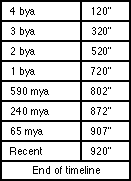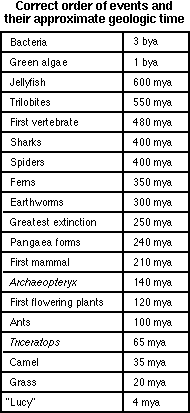WHAT CAME FIRST?JUDITH SCOTCHMOORTHIS ACTIVITY is an effective follow-up to Sequencing Time. After sequencing events in their own lives and assigning each a numerical time, students use the same process to sequence actual events in the evolution of life on Earth.Objectives: (1) Students will gain an understanding of deep time — 4.6 billion years of Earth's history. (2) Students will become familiar with events in the Earth's history and how they relate to one another. Explore these links for additional information on the topics covered in this lesson: MATERIALS A timeline made of adding machine tape or strips of vinyl glued together. You will need a
length of 25.5 yards. (A product called Goop is an excellent adhesive for the vinyl strips.
Prepare the timeline using a scale of 1" = 5 million years. The timeline begins 4.6 billion
years ago. Mark this at one end of the timeline. Place the following information at the
distances indicated below. (bya = billions of years ago, mya = millions of years ago)
A timeline made of adding machine tape or strips of vinyl glued together. You will need a
length of 25.5 yards. (A product called Goop is an excellent adhesive for the vinyl strips.
Prepare the timeline using a scale of 1" = 5 million years. The timeline begins 4.6 billion
years ago. Mark this at one end of the timeline. Place the following information at the
distances indicated below. (bya = billions of years ago, mya = millions of years ago)

PROCEDURES1) Hang the timeline around the room and discuss what it is. See if students can name any of the time periods. Identify the Pre-Cambrian, Paleozoic, Mesozoic, and Cenozoic.2) Ask each student or team of students to pick one Event Card. Explain that each card represents the first evidence of an organism in the fossil record or the occurrence of a particular event during the Earth's history. 3) Have students arrange themselves in sequence according to their event — the oldest event first and the most recent last. 4) Undoubtedly there will be some errors. Most students are surprised that grass is so recent and spiders are so old! Allow discussion as you place them in the correct sequence. 5) Now that the proper sequence of events has been determined, ask students to stand in front of the timeline at the place that represents the right age of the event. 6) Once again, there will probably be many errors. Move them to the correct places and discuss. Students are surprised to see that for very long periods of early history, very little happened. Then there was the Cambrian Explosion!
Extensions:
|